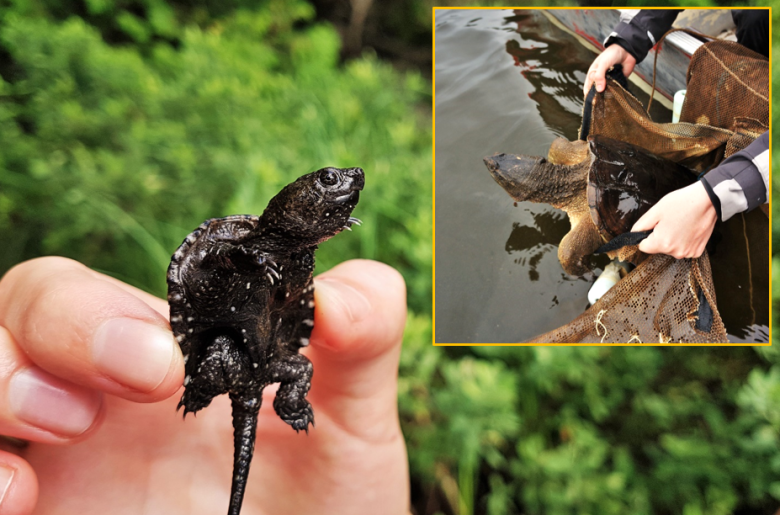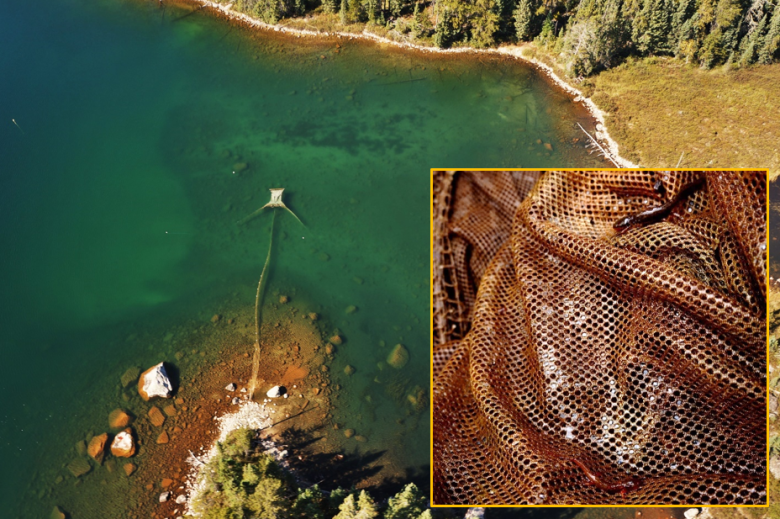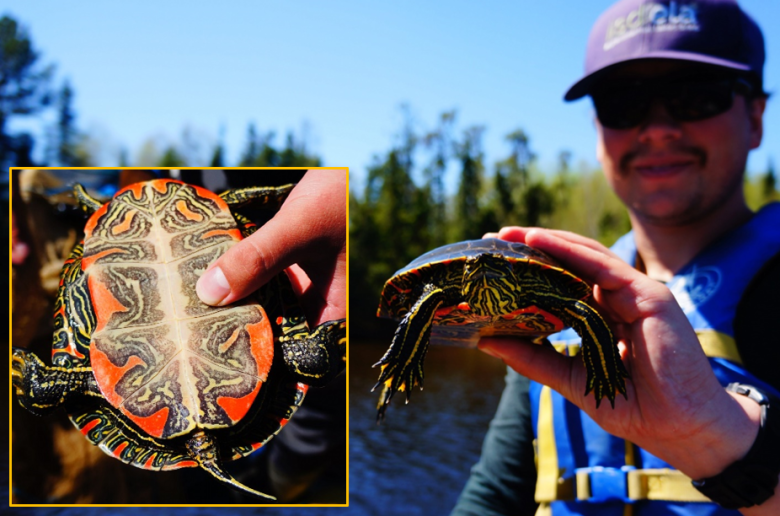Research February 16, 2021
Historical Herpetological Bycatch at the World’s Freshwater Laboratory
By Lauren Hayhurst, Fisheries Research Biologist
How is your “creeping animal” knowledge?
Herpetology is the study of reptiles and amphibians—from their genetics and behaviour in the environment to the extent of their geographic ranges.
These cold-blooded (“ectothermic”) species are important indicators of aquatic ecosystem health. This is because they are important nutrient recyclers in the food web, they can live both in water and on land, they can partly respire through their skin (i.e., amphibians), and they are sensitive to pollution and habitat disturbances.
There are few large-scale efforts to assess reptiles and amphibians in remote areas of the Boreal Shield in Canada, and long-term records of herpetological observations are rarely encountered or are not available in meaningful formats.

No [fish] is an island.
Since 1973, fisheries researchers at IISD Experimental Lakes Area have monitored our lakes, and additional lakes in the area, to determine changes at the fish levels before, during, and after whole-ecosystem studies.
We use non-lethal methods to capture fish, so we can measure, collect non-lethal tissue samples, assess condition, and estimate abundance, which gives us an idea of changes in fish on both the individual and population “scales.” Fish results are compared to other biological, chemical, and physical parameters collected and analyzed by other research crews so we can identify and assess changes in the entire lake.
Like our comprehensive whole-ecosystem studies, our freshwater lakes host a wide variety of species with complex communities and interactions. While setting and retrieving our fish nets and traps, we also inadvertently capture herpetological species that we are not targeting for research—we refer to these bonus (legged) species as “bycatch.”

We combed through the pages of our historical records of fisheries efforts and catches to investigate the sightings of snapping turtles (Chelydra serpentina; 44 years of records), painted turtles (Chrysemys picta; 43 years of records), and eastern newts (Notophthalmus viridescens; 38 years of records) in 79 lakes in and around IISD-ELA, near the northern edge of their geographic ranges.
These recorded observations of “one giant snapper” or “small painted turtle” or “two newts,” in addition to all the fish counts and metrics, allowed us to assess where these bycatch species have historically been encountered, as well as to calculate the amount of effort (i.e., number of nets in the lake and number of net set days) that it took to encounter them.
From there, we determined the density of these herpetological species in our lakes and their general abundance trends over time. Despite recording these sightings since 1977, we have never formally identified their presence in our lakes and submitted our findings to the broader research community. This is, therefore, the first time the presence and abundance of snapping turtle, painted turtle, and eastern newt species in this remote area of the Boreal Shield have been published!

And make it snappy!
Snapping turtles are semi-aquatic reptiles that travel long distances for nest sites, mates, and prey. They act as natural recyclers in aquatic ecosystems—they prey on and scavenge all manner of invertebrates, fish, birds, mammals, and other reptiles. They are slow to reach sexual maturity (i.e., 15 to 20 years), and they can live to be over 100 years old. The largest snapping turtle ever recorded was captured in Minnesota, United States, weighing 29 kg and measuring 49.5 cm across the length of its shell! Snapping turtles have very low survival rates of eggs and hatchlings and therefore rely on almost zero adult mortality to maintain their numbers.
Their populations are in decline across their North American range due to habitat degradation and collection for the pet trade. Hunting and trapping were legal in Canada until 2017 (and are still legal in the United States), despite snapping turtles being listed as a “species of special concern” by the Species at Risk Act and a “specially protected reptile” under Ontario’s Fish and Wildlife Conservation Act (FWCA).
We encountered n=154 common snapping turtles as bycatch in our nets set in 23 lakes (21 of these are designated IISD-ELA lakes) from 1977 to 2020.

It’s turtles all the way down.
Painted turtles are the most widespread turtles endemic to North America. They live in slow-moving fresh water, where they are often observed swimming or basking during the ice-free season. But did you know that they hibernate, buried in the mud in the low-oxygen (“hypoxic”) or no-oxygen (“anoxic”) bottoms of ice-covered lakes and ponds, where they slow their metabolism and diffuse oxygen through their butts (“cloacal respiration”)? Like sea turtles, the likelihood of painted turtle hatchlings being male or female is not determined by genetics but by temperature—eggs that incubate at lower temperatures will be predominantly male; eggs that incubate at higher temperatures will be predominantly female, and fluctuating temperatures will produce a mix of males and females in a nest!
Due to an increase in road mortalities, painted turtles were recently listed as a “species of special concern” by the Committee on the Status of Endangered Wildlife in Canada (COSEWIC) for part of their geographic range (i.e., Pacific Coast and Intermountain) and for a couple of their sub-species (i.e., Midland and Eastern). They are also considered a “specially protected reptile” under Ontario’s FWCA.
We encountered n = 351 western painted turtles as bycatch in our nets set in 24 lakes (23 of these are designated IISD-ELA lakes) from 1978 to 2020.

That’s a neat newt!
Eastern newts are salamanders with a complex life cycle involving aquatic eggs and gilled larvae (for half a year), a move to land for their lung-breathing juvenile “red eft” stage (for 2–3 years), and a return to the lake as lunged adults (for 6–7 years). Occasionally, if aquatic conditions are favourable or terrestrial conditions are unsuitable, eastern newts may skip their terrestrial stage and remain in the water (“neoteny”), which is evidenced by the retention of their larval gill fragments that would dry up and be brushed off if they had ventured on land.
Eastern newts are toxic at all life stages—they produce a neurotoxin called tetrodotoxin that is concentrated at the surface of their skin and causes muscle paralysis when ingested. While some fishes and garter snakes can tolerate consuming their toxic skin, raccoons have been observed decapitating and skinning newts! Eastern newts occur in a wide variety of water bodies ranging from semi-permanent ponds to lakes, where they can remain active throughout the year. They are “unlisted” under both the Species at Risk in Ontario and the Endangered Wildlife in Canada status committees, and they receive no protection under Ontario’s FWCA.
We encountered n = 784 eastern newts as bycatch in our nets set in 19 lakes (17 of these are designated IISD-ELA lakes) from 1983 to 2020.

Slow and steady wins the race.
Even though our fisheries collection and capture methods were not designed to target reptile and amphibian species—and therefore represent a minimum of encounter occasions—these historical records provide us with comprehensive summaries of the net and trap catches, which allowed us to determine the local- and landscape-level abundance trends of reptiles and amphibians, historically.
While this herpetological research may seem niche, with further investigation, these ectothermic species may reveal a great deal about the health of our ecosystems—not restricted to the lakes but encompassing the surrounding terrestrial environments.
In this remote area of the Boreal Shield, at IISD-ELA, we get a unique insight into what these ectothermic species’ statuses might be in the presence of global warming trends (e.g., increased temperatures, increased ice-free period, increased precipitation, etc.) but in the absence of development and disturbances caused by humans (e.g., habitat loss, road mortalities, pesticides and pollutants, etc.).
Stay tuned as we expand our herpetological research range and abundance like newts across the landscape!
This research was carried out in collaboration with Dr. Stephen Hecnar at Lakehead University.
You know that ground-breaking freshwater research you just read about? Well, that’s actually down to you.
It’s only thanks to our generous donors that the world’s freshwater laboratory—an independent not-for-profit—can continue to do what we do. And that means everything from exploring what happens when cannabis flushes and oil spills into a lake, to how we can reduce mercury in fish and algal blooms in fresh water—all to keep our water clean around the world for generations to come.
We know that these are difficult times, but the knowledge to act on scientific evidence has never been more important. Neither has your support.
If you believe in whole ecosystem science and using it to bring about real change to fresh water around the globe, please support us in any way you are able to.